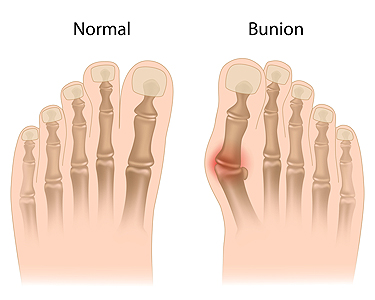

A bunion is identified as a bony protrusion that gradually forms on the side of the big toe. It affects women more than men, and this may be a result of the type of shoes that are frequently worn. High heels fall into this category, because they have little room for the toes to move freely in. Limiting the time wearing high heels is suggested. If medical attention is not sought, the growing bunion can cause the other toes to shift toward each other, and larger shoes may need to be purchased. Research has shown that men are also affected by bunions, most commonly due to genetic reasons. Foot structure and bunions tend to run in families, and it is beneficial for men to be aware of the type of shoes they choose to wear. Effective prevention methods include buying shoes that can adequately accommodate the width of the toes. If you have a bunion, it is suggested that you consult with a podiatrist who can determine what the right course of treatment is for you.
If you are suffering from bunions, contact Dr. Alan J. Spector of Shore Podiatry. Our doctor can provide the care you need to keep you pain-free and on your feet.
What Is a Bunion?
A bunion is formed of swollen tissue or an enlargement of boney growth, usually located at the base joint of the toe that connects to the foot. The swelling occurs due to the bones in the big toe shifting inward, which impacts the other toes of the foot. This causes the area around the base of the big toe to become inflamed and painful.
Why Do Bunions Form?
Genetics – Susceptibility to bunions are often hereditary
Stress on the feet – Poorly fitted and uncomfortable footwear that places stress on feet, such as heels, can worsen existing bunions
How Are Bunions Diagnosed?
Doctors often perform two tests – blood tests and x-rays – when trying to diagnose bunions, especially in the early stages of development. Blood tests help determine if the foot pain is being caused by something else, such as arthritis, while x-rays provide a clear picture of your bone structure to your doctor.
How Are Bunions Treated?
If you have any questions, please feel free to contact our office located in Point Pleasant, NJ . We offer the newest diagnostic and treatment technologies for all your foot care needs.